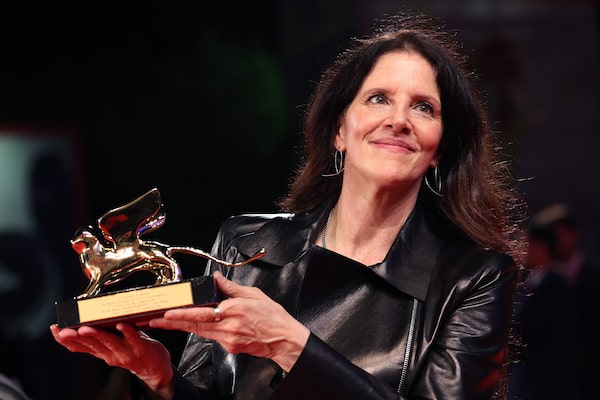
Laura Poitras's All the Beauty and the Bloodshed won this year's Golden Lion for Best Film at the 79th Venice International Film Festival.Vittorio Zunino Celotto/Getty Images
Filmmaker Laura Poitras is used to having people’s lives in her hands. In 2013, it was U.S. National Security Agency whistleblower Edward Snowden, subject of Poitras’s revolutionary documentary Citizenfour. And now, in a slightly different though still weighty fashion, it is the life of acclaimed New York photographer Nan Goldin.
In her new doc All the Beauty and the Bloodshed, Poitras weaves the remarkable life and career of the fearless and taboo-busting Goldin with the rise of the opioid crisis. The result is a painfully intimate portrait of an artist, and an American tragedy. Ahead of the film’s theatrical release in Canada this week, Poitras spoke with The Globe and Mail about the art of collaboration and the tremulous state of the documentary field.
The film is being billed as a true collaboration with Nan Goldin, almost as if she was co-directing. What was that relationship like in practice?
Nan began making this film before I even joined – she was documenting her work with [the advocacy group Prescription Addiction Intervention Now] for a year and a half. There was always the understanding that it would be collaborative, and it’s not that unusual. In every film that I’ve done it’s on a case-by-case basis.
Is it challenging to give up any sense of control compared to the traditional director-subject relationship?
I still have final cut on the film, so it was always clear to me that Nan … she is giving so much, and she has so much at stake. A film like Citizenfour about global surveillance was one way of reporting and filmmaking, and this is a very different type. The collaborative nature was something that Nan very much uses in her own work, too. When she photographs someone, she wants them to be happy with the work. There’s a dialogue.
Was there any tension that bubbled up in the process?
Have you ever talked to someone off the record, as a journalist? You know that when you agree to do so, it’s because someone is sharing something in which there’s a risk to sharing it, but you do so to build trust and then hope that they’ll eventually go on the record. It was like that. We talked a lot. And if she had, for instance, decided to not want to include her sex work in the film, I would’ve respected that.
Do you feel that you know her the best of all your previous documentary subjects?
It’s possible. [Long pause.] The process went to a really deep place. There is a different quality to the intimacy. When I think about Edward Snowden, that was someone who literally trusted me with their life. I felt the burden of being sure not to mess that one up. This was a different set of burdens. I wasn’t interviewing Snowden about every aspect of his life, like Nan. It’s a different kind of knowing someone.
Laura Poitras in New York on Nov. 8.THEA TRAFF/The New York Times News Service
What are your thoughts on the current documentary landscape? There have been several stories over the past few months about the pressure that streamers are putting on documentarians to pump out quick hot-topic docs with lax fact-checking and quality control.
From my point of view, I’m in a very lucky position. I have final cut on my films and I’m coming in with a track record that helps me navigate this more easily than other younger filmmakers. There are a lot of different forces happening right now. On one hand, there is this amazing expansion of the documentary form. At the same time, you have constrictions around these commercial formulas, which is alarming.
It’s good that filmmakers can support themselves, that more films can be made. But then there are just a bunch of things that make me go, oh god, not another serial killer film where they don’t contact families. The ethical lapses are hard to process. How are people sitting around in a room making these decisions?
I wanted to ask you about some sharp comments you made while at the Toronto International Film Festival this fall, about the inclusion of Hillary Clinton at the Toronto and Venice festivals, and how that bordered on a “whitewashing” of her history. What was the reaction to that?
Well, let me clarify that there was no inclusion of any Clinton-supported films at Venice. She was just there on the red carpet, and then she gave some interviews for her support of the new fascist leader of Italy. The reason I brought it up, and I’m not trying to get myself in trouble, but documentaries are journalism, and we don’t want to forget that. It’s not just entertainment, a place to have a party or walk the red carpet. Clinton has a long history of influencing global politics. I just question that. But I do want to reiterate my love for filmmakers and festivals. The critique was much more directed at Clinton.
All the Beauty and the Bloodshed opens in select theatres Dec. 2
This interview has been condensed and edited
 Barry Hertz
Barry Hertz